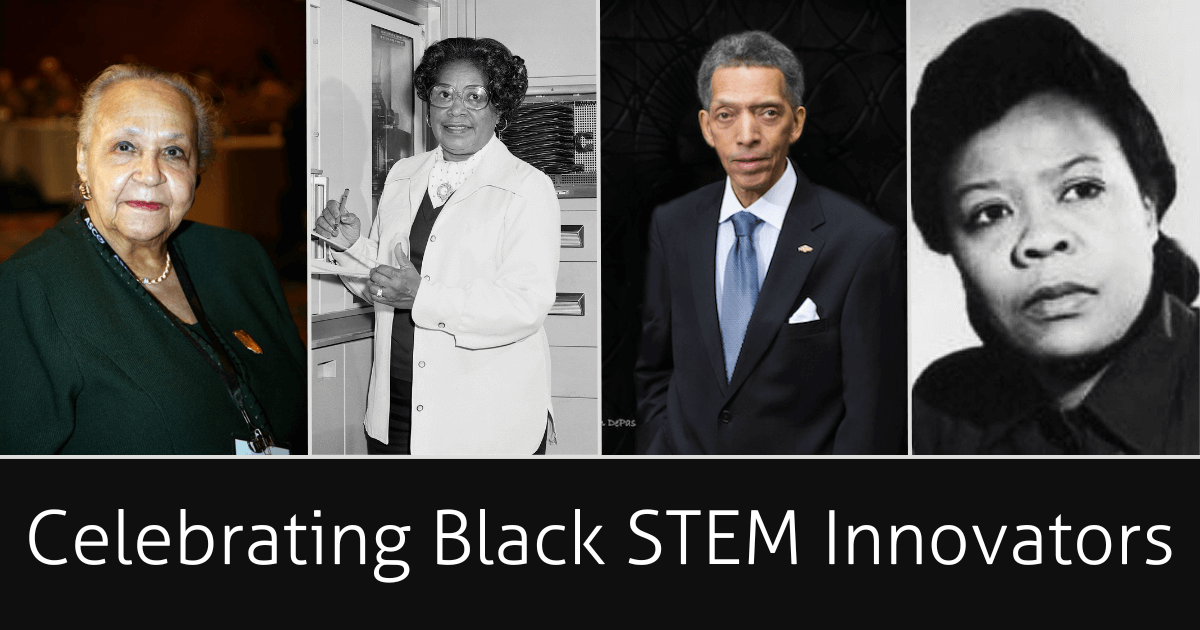At Eduporium, we take pride in being a minority-owned business and one of few tech companies to have a Black CEO. Our president and CEO, Rick Fredkin, was named a tech leader in Massachusetts and has been saluted for participating in a Black Lives Matter demonstration with his family. His story, as well as the stories of other Black STEM innovators, is an inspiration for us to keep expanding tech access for young Black students. So, we're highlighting other major achievements of Black STEM leaders throughout history.
Mary W. Jackson's Contributions to STEM
NASA's first Black female engineer, Mary W. Jackson (second from left, above), was a powerful advocate in the organization's inclusion of women. During Jackson's 34 years with NASA, where she earned the title of senior engineer, she contributed to 12 technical papers. She also worked extensively with the Supersonic Pressure Tunnel project, studying air flow forces like drag and thrust to help improve the construction of airplanes. Eventually, she petitioned for the right to take engineering classes at an all-white university and began working within the high-speed aerodynamics and compressibility research divisions (among others). These contributions remain incredibly significant in NASA's mission to send Americans to space.
Despite experiencing segregation when she started as an engineer, Jackson ultimately led efforts at NASA to hire and promote women within the program’s STEM positions. She worked as a program manager for the Office of Equal Opportunity and the Affirmative Action program, paving the way for women and people of color at NASA. Jackson died in 2005 and received the Congressional Gold Medal in 2019. In her honor, NASA's Washington, D.C. headquarters were renamed the Mary W. Jackson NASA Headquarters in 2021.
Marie Van Brittan Brown's Invention
Now a staple in countless residences, modern home security systems emerged thanks to Marie Van Brittan Brown (right, above). While she was living in a neighborhood with a high crime rate, Brown—a nurse by trade—created her first security system for her own safety. Her invention, which she would patent by 1966, used radio-controlled cameras to send live images to a monitor.
Complete with a two-way microphone that allowed residents and visitors to converse, her security system became a paradigm for future designs—though perhaps with even more features. Her system included a remote control to unlock the door and a button to notify the police. As the first use of video surveillance outside of the military, Brown's invention was a notable feat for STEM. In fact, the model for her system is still utilized in small businesses, offices, single-family homes, apartment complexes, and condos.
Jane C. Wright's Medical Genius
Born into a family of physicians, Jane C. Wright (left, above) distinguished herself with numerous notable contributions to cancer research. After earning multiple medical degrees, as well as an art degree, Wright joined her father in 1949 at the Harlem Hospital Cancer Research Center, which he'd founded. There, the father-daughter team worked together towards making chemotherapy, which was a new treatment at the time, more accessible. They were the first to use folic acid antagonists against the proliferation of cancer, and chemotherapy drugs created from their discovery are still in use today.
After her father's death, Wright succeeded him as director of the research center and developed multiple effective cancer treatments. She pioneered a method of combining chemotherapy drugs to increase their effectiveness while avoiding side effects. She also created a method for delivering these drugs to tumors located deep within the body by means of a catheter, which was far safer and easier than surgery. As one of few women (and even fewer Black women) known for mid-20th-century cancer research, Wright's work still benefits women of color and cancer patients to this day.

Alan Emtage and His Role in STEM
Alan Emtage worked as a systems administrator at Montreal's McGill University when he invented the very first Internet search engine in 1989. While looking for ways to save time when locating software, Emtage created a program to search the servers for him. He dubbed this search engine 'Archie,' a play on the word "archive." The invention led to the prototype for today's robust search engines. Indeed, Emtage often jokes that Archie was the great-great-grandfather of Google.
After inventing Archie, Emtage continued making meaningful contributions to STEM as a founding member of the Internet Society. He was also heavily involved with the Internet Engineering Task Force, which helped establish the standard for uniform resource locators. You probably know them better as URLs. Along with a long list of achievements in computer science, Emtage also served on many panels with prestigious groups that would include the National Science Foundation, Library of Congress, and the Online Computer Library Center. So, next time you’re using a search engine, you probably have Alan Emtage to thank.
Euphemia Haynes' Teaching Career
Euphemia Haynes made many of her STEM contributions in the classroom. Throughout her own education, Haynes displayed strong skill in mathematics and earned a lengthy list of honors. She was valedictorian of her high school class and then earned an education degree at the University of the District of Columbia, an undergraduate degree in mathematics from Smith College, and her master’s degree in education from the University of Chicago. She also earned a PhD at the Catholic University of America in 1943, becoming the first African American woman to earn a PhD in mathematics.
Haynes spent her whole life in Washington, D.C., teaching with the D.C. public school system for 47 years. After that, she became the first woman to serve as the chair of the D.C. Board of Education, a platform she used to advocate for the rights of Black students in the city. Most notably, she criticized the “track" system in the city’s schools, which assigned students to vocational paths based on their ability. Haynes argued that the track system discriminated against Black students by assigning them to specific tracks without consent or feedback. Because of her outspoken advocacy, the track system was abolished in 1967, during her tenure as the chair. Throughout her lifetime, Haynes' commitment to dismantling segregation broke down barriers and advanced STEM opportunities for many.

George Carruthers Impacting STEM
George Carruthers was a scientist and inventor whose significant contributions to STEAM include creating an ultraviolet camera/spectrograph. Carruthers' first foray into STEM was a cardboard telescope, which he built at the age of 10. He went on to earn a PhD in aeronautical and astronautical engineering. After he had graduated, Carruthers worked for the U.S. Navy and helped create the spectrograph that would eventually accompany the Apollo 16 rocket on its trip to the moon.
Carruthers' spectrograph allowed scientists to examine Earth's atmosphere for pollutants for the first time. They could also now see UV images of stars, nebulae, and galaxies. It also captured the first proof of molecular hydrogen in space. As Carruthers perfected his inventions, he helped scientists capture UV images of Halley's Comet using one of his cameras. These advancements greatly increased scientists' knowledge of space, as well as their ability to study and classify interstellar substances.
Later on, Carruthers created the Science and Engineers Apprentice program, giving high school students a chance to work at the same Naval Research Laboratory where he once did. He even taught Space Science for Howard University, a well-known HBCU. His achievements not only helped further contemporary space research but also continue to inspire students and researchers today.
For the latest EdTech, STEAM, and 21st-century education news, follow us on Twitter (X) and Instagram. Like us on Facebook, too, or sign up for our newsletter for all of our newest product announcements and offerings. If you have a compelling story about students making an impact in STEM or in your communities, we'd love to share. Drop a comment below or get in touch with us anytime. Also, if you're ever looking for ways to enhance education equity in your school or district, we can help.




2 Comments